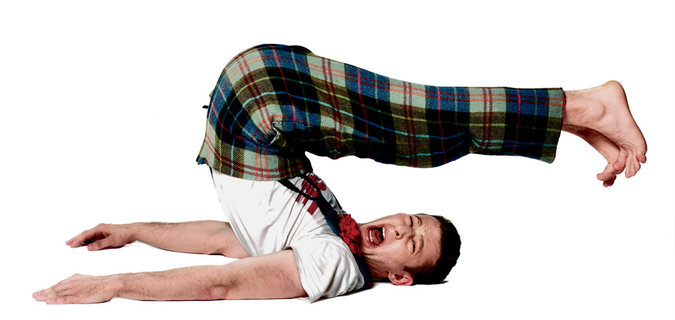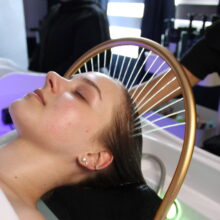Spa Alert: Uproar re NY Times Article, “How Yoga Wrecks Your Body.” Red Flag Needed.
- Published: Monday, January 16th 2012
- in Living Well

Nick Blaemire: The plow was the easiest position of the day — though it is quite a strange feeling having your face that close to your knees. Credit Danielle Levitt for The New York Times
Ok, let’s calm down. Perhaps we should all take a collective deep yoga breath.
One morning a couple of weeks ago I noticed an article in the NY Times Magazine titled, “How Yoga Can Wreck Your Body.”
It was quite lengthy (3500 words to be exact per my trusty Microsoft Word word-counter). It got quite a bit of attention – due to its length, and the title no doubt.
Initially I read through the first half of the article and skimmed the second. I was a tad overwhelmed with all the negativity and examples of people who had experienced horrible injuries as a result of something that happened in a yoga class – broken ribs, strokes, brain injuries. Scary.
Being fairly familiar with the medical evidence for yoga (thanks to www.spaevidence.com where you can find the medical research for yoga quite easily ) my initial reaction was fairly pragmatic. I know there is a lot of evidence to support positive outcomes from practicing yoga and so I thought it probably wasn’t such a bad thing that someone was pointing out the risks. After all, it is something my aging body has begun talking to me about as well lately.
A few days later several people at the office mentioned the “How Yoga Can Wreck Your Body” article and asked for my opinion.
Later in the week, I attended a press luncheon announcing our SpaFinder Top 10 Spa Trends for 2012 and the topic came up again – this time in casual conversation after the luncheon. There were some rather strong opinions expressed ranging from people feeling that the reporting was very one-sided to others who could relate as they too had had (or witnessed) injuries in yoga classes.
I thought I better go back and read the article again.
Sure enough, I noticed a few things that I had completely missed the first time around. For one, most of the mentions about serious injuries were from research reported in the early 70’s. In fact (and yes, I checked using that Microsoft Word counter again) 1500 words of this article were attributed to these early 70’s findings.
Also the statistics mentioned from the Consumer Product Safety Division showing that there were 13 emergency hospital admissions due to yoga injuries in 2000 compared to 20 in 2001 and 46 the next year seemed to ignore the fact that there were also very likely more people doing yoga.
And frankly, I didn’t think the number of injured was all that high. I am sure more people end up in emergency rooms due to crossing streets than are injured doing yoga and we aren’t exactly suggesting people quit doing that. And we have all heard about people dying during sex – and as far as I can tell, that hasn’t started a movement encouraging “extreme caution.”
But the biggest ah-ha came when I noticed this statement at the very end of the piece:
“ This article is adapted from “The Science of Yoga: The Risks and Rewards,” by William J. Broad, to be published next month by Simon & Schuster. Broad is a senior science writer at The Times. Editor: Sheila Glaser.
This entire piece was just an excerpt from a 336 page book. It must have been the editor Sheila Glaser who decided on what excerpt of the book to publish. And we do not know – and this is extremely important – who decided on the title of the article.
It was the title of this article and the selection of the excerpt that was causing all the fuss. And for that, I feel we need to throw up a red flag!
When you have a book about the risks and rewards of something, to just publish the risks (or just the rewards) and slap a title on it to underscore that point of view, resulting in the impression that this is the conclusion of someone’s five years of investigative work, well, I think that is misleading.
Because I am involved in the writing and publishing world to some degree (our various SpaFinder publications and articles or interviews I do for other publications), I have learned that the person who is the source of the information DOES NOT SELECT THE TITLE OF THE ARTICLE. And the source does not decide on WHAT EXCERPTS ARE QUOTED.
Those decisions are made by others. Often, the excerpts are decided by the editor and someone entirely different decides on the title (usually someone who is very good at selecting “attention-getting” titles.) This is likely what happened in this case. The result? Lots of feathers got ruffled. The truth? Something you have to really dig for.
The Science of Yoga book isn’t out yet nor is the e-version available today. Apparently it will be available in February. Common sense tells me however that if a writer is a respected science writer for the NY Times (he has received two Pulitzer Prizes!), has researched a book for five years and written 336 pages, it is unlikely that the entire focus is on “How Yoga Wrecks Your Body” – a headline that seems more suited for a tabloid magazine rather than the NY Times.
Further digging I found these quotes labeled “Praise for the book” (possibly these are on the book’s back cover?) Hmm – an entirely different tone:
Yoga, an ancient practice with millions of modern practitioners, has been the subject of overheated speculation and grandiose claims; it has been dismissed without warrant as well, underappreciated by some who might well benefit from it. The Science of Yoga is a lucid and long overdue account of what scientists have found in their attempts to ferret out the truth about what yoga can and cannot do to heal and make better the body and mind. It is a fascinating and important book.” — Kay Redfield Jamison, author of An Unquiet Mind and Touched With Fire
“The Science of Yoga offers a riveting, much-needed, clear-eyed look at the yoga mystique. In this investigation, science journalist William Broad pulls back the curtain on the little-discussed world of yoga injuries and risks, while setting the record straight about the numerous potential benefits. Downward dog will never look the same.” — Daniel Goleman, author of Emotional Intelligence
“If this book doesn’t motivate you to practice yoga, nothing will. Broad sheds light on yoga’s health benefits and hoaxes, covering everything from headstands to hypertension, the vagus nerve to the YogaButt. Finally I understand why I feel so good when I do yoga.” –Priscilla Warner, author of Learning to Breathe— My Yearlong Quest to Bring Calm to My Life and co-author of The Faith Club
“William Broad is optimistic and hopeful in pointing the way to its future as a major force in preventing and treating disease.” — Gail Sheehy, author of Passages in Caregiving
Bottom line? For me, several conclusions:
- Few things are all good or all bad – yoga included. www.spaevidence.com is a place I can go to get transparency. It takes me to the actual medical evidence for various spa modalities so I can put things into context myself. The fact that yoga gets so many high “A”and “B” ratings (that very few other spa or wellness modalities receive), is impressive. http://www.spaevidence.com/spaevidence/yoga/research
- Am planning to download “The Science of Yoga: Risks and Rewards” when it comes out next month and see what more I can learn from Broad’s five years of investigative work. I have a feeling the book is going to be a great contribution when read in its entirety. At some point I hope to learn what the author of the book might have thought about the NY Times piece.
- I am reminded to continue being diligent about headlines as they have fooled me before. Alas, I need to be on my toes when reading the NY Times now as well.
- And finally, I plan to continue doing yoga as part of my weekly exercise regime and I am going to feel just fine about not being in the advanced class anymore where they are doing headstands and back arches.


